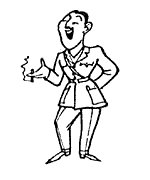Punch Gallery
The following images are taken from Punch Magazine during the war.

THEY SHALL NOT PASS!
DATE: August, 1914
ARTIST: F.H. Townsend.
COMMENT: Townsend was the art editor of the paper, and usually had the “lead” pictures in the magazine. This picture of “Little Belgium” is one of the most reproduced pictorial images of the war. The artwork is exceptionally well-composed, enhancing both racial stereotypes of the German Kaiser, and pastoral imagery (the “defenceless” church in the background) which was essential to the English understanding of Nationhood.
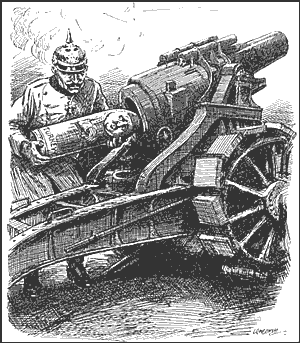
Kaiser: Leave everything to me. All you’ve got to do is explode.
Turkey: Yes, I quite see that. But where shall I be when it’s all over?
DATE: 11th November, 1914.
ARTIST: Raven Hill.
COMMENT: Turkey was often portrayed in this way by British cartoonists; as a misguided partner to the villainy of the Kaiser, or alternatively as the opiate “Sick Man Of Europe”. The battery gun show here is surprisingly accurate (for Allied weaponry). Whilst Germans were often shown offensively, it was rare to see the Allies depicted firing anything more than rifles.
“A GLORIOUS EXAMPLE.”
Able Bodied Citizen (to Territorial) “That ought to give you a good lead, Mate.”
Territorial “Yes – And I mean to take it! What about you?”
DATE: November
11th, 1914
ARTIST: Bernard Partridge.
COMMENT: An obvious recruitment cartoon. The “Great Charge”
mentioned on the billboard is the First Battle of Ypres, which Sir John French
was commanding from the front lines. At one point he was so certain of defeat
that he said to General Foch “There is nothing left for me to do but
go up and be killed with 1 Corps”. Bernard Partridge was chief cartoonist
of Punch, and cleverly (or lazily) specialised in drawing cartoons
with only two people. However, the social realism of these characters was
far more accurate than any of his contemporaries, as can be seen in the clothes
and posture of both men.
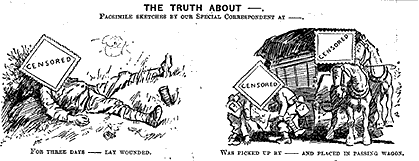
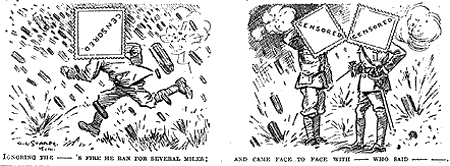
DATE: 12th November, 1914
ARTIST: G.L.Stampa
COMMENT: Extracts from this cartoon which satirise the difficulty of war
reportage and writing accurately about the war. The two bottom pictures show
characters standing in a hail of shells, however, demonstrating how at this
point in the war the little about the front lines was understood by the civilian
public.
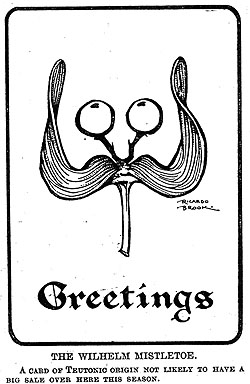
THE WILHELM MISTLETOE.
A card of Teutonic Origin not likely to have a big sale over here this season
DATE: December 23rd, 1914
ARTIST: Ricardo Brook
COMMENT: Proof that the humour of 1910’s Britain was a strange and unreadable thing….

Near Sighted Old Lady (a keen recruiter): “Now look at that young fellow. A couple of months in the army would make a new man of him!”
DATE: July
28th 1915
ARTIST: Frank Reynolds.
COMMENT: As discussed in the Cinema section, Chaplin was criticised for not participating in the war. Recruitment fervour amongst the general public, especially of people unlikely to ever have to fight themselves was one of the main topics of the cartoons and articles in Punch.

Bored Sentry. “Come Along! ‘Urry up and take a turn at watchin’ this blooming turnip.”
DATE: October
13th, 1915
ARTIST: G.D.ARMOUR.
COMMENT: Another sketch of
the trenches showing very little knowledge of the situation at the front,
this cartoon very typically shows No-Man’s Land as a hazy scrawl. The
idea that the war will not result in a quick victory is implicit in the idea
that the soldiers have a chance to watch vegetables growing. Also suggested
by this action is the “pluck” and bravery of the British Tommy.
AFTER ONE YEAR.
DATE: 11th
August, 1915
ARTIST: Raven-Hill
COMMENT: An allegorical reminder of the motifs for the war – this stresses how the fighting was encouraged as a moral conflict, rather than a military one. Surprisingly the cartoon is very heavily inked, and the storm clouds surrounding the figures seeming to suggest a more depressing attitude.
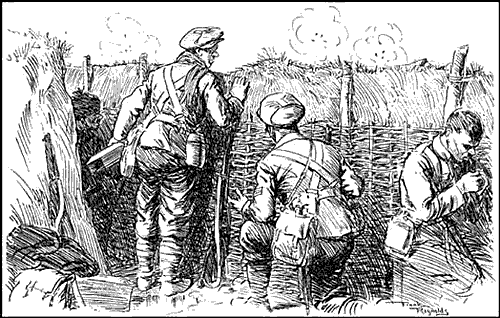
Sergeant. Now then my lad, you’re asking for it. Why don’t you use your periscope ?
Tommy. I was using it, and twice I nearly got a bullet through it.
DATE: 20th October 1915
ARTIST: Frank Reynolds.
COMMENT: Another inaccurate realisation of what a trench looked like, and the standard attitude of Punch towards the working classes – that Tommies were all nice but dim.
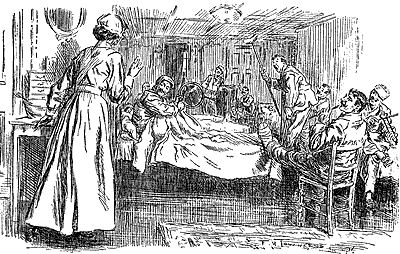
THE IRREPRESSIBLES.
Nurse (of private hospital)” A message has just come in to ask if the hospital will make a little less noise, as the lady next door has a touch of headache.
DATE: January 19th 1916
ARTIST: F.H.Townsend.
COMMENT: Although this cartoon acknowledges that there were casualties, it diffuses this by making them all festive (upholding the maxim to “keep cheerful”), and drawing all of them with non-debilatating injuries. Although all the solderis have accepted wounds (to the head or limbs) There are no disfiguremnts or amputations. The term “private hospital” possibly means one set up by volunteers, rather than an official ward.
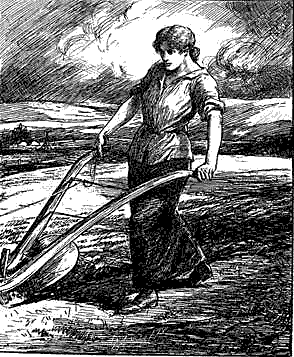
PRO PATRIA
A tribute to woman’s work in war-time.
DATE: January 26th, 1916
ARTIST: (?)
COMMENT: Punch veered between deriding women’s war-work and praising it. This cartoon is very unusual however, as it centres around the relative strength of women without removing the femininity of the figure pushing the ploughshare. Farmwork is the dominant topic for comedy about women in the magazine because it was felt to encourage masculine behaviour. Unfortunately it was also because women were far less successful at being farmers than they were at becoming munitions workers, secretaries, drivers or taking jobs in the cities.
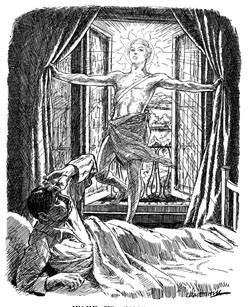
WAKE UP ENGLAND!
The Sun (to householder)”Now then, why waste your daylight? Save it and give it to the country.
(If only for the sake of economy in artificial light during War-Time, the Daylight saving scheme should have the support of all patriots.)
DATE: May 10th, 1916
ARTIST: Raven-Hill
COMMENT: Along with pub closing during the day, daylight saving was instigated partly to keep the population under control during the war. The entirely innocent art is again something that a modern viewer finds hard to regard without irony.
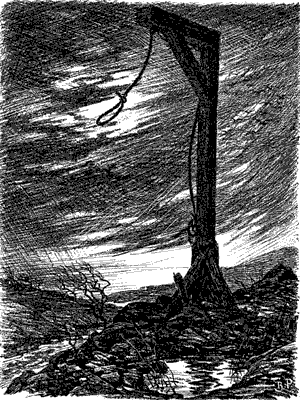
FOR TRAITORS
A warning to promoters of strikes in wartime
DATE: April 5th 1916
ARTIST: B.P.
COMMENT: An extremely aggressive reaction to factory strikes in mid- 1916, this lead illustration is heavily inked and again uses the imager of athe rural (the landscape in the background) under threat.

His Fiancee “He had very bad luck. He was knocked over by a ricochet.”
Her Aunt “Really? I didn’t know the Germans had any native troops fighting for them.
DATE: April 12th, 1916
ARTIST: G.L.Stampa.
COMMENT: Punch was very much aware of how misinformed the British population could be, and cartoons like this were very common. This is an attitude not often considered by modern readings as it is often assumed that all of the population were wilfully ignorant of the conditions at the Front. The two women are both satirised here – the fiancée for boasting, and the aunt for ignorance. Again the soldier’s wound is invisible and connoted by a walking stick. The idea that he has had “bad luck” is another attempt to dismiss the dangers of the war. At this point in the fighting, approximately 1 in 5 men became casualties.
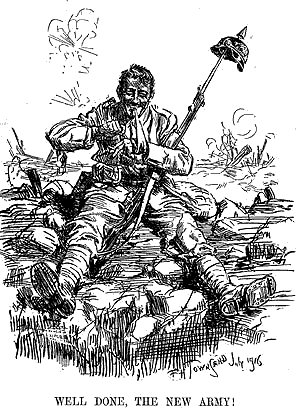
DATE: July 12th, 1916.
ARTIST: F.H. Townsend.
COMMENT: Punch’s reaction to the Battle of The Somme, in which the British suffered 60 000 casualties, including 20 000 dead, on the first day. The main fighting involved the first wave of Kitchener’s Army, including the famous “Pals” Battalions, comprised largely of men from the same area. The working class Tommy depicted is shown “licking his wounds” , acknowledging that there were some casualties but yet again implying they were not serious. The aggressive placement of the rifle and fixed bayonet is broken up by the German helmet covering the end of the blade.
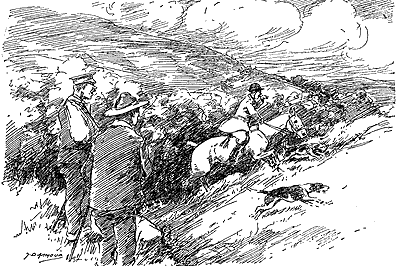
Wounded Soldier(seen hunting for the first time) “Wot’s up now, Billy? Gas alarm?”
DATE: October 25th, 1916
ARTIST: G.D.Armour.
COMMENT: Owen Seaman, the editor of Punch, complained that G.D.Armour’s cartoons were insistently about either hunting or sport; here the artist has managed to cram one of these into a war cartoon. The cartoon appears to refer to shellshock (in a very mild form); there is aan awareness that a preoccupation with the war for its veterans was a very common occurrence. Robert Graves confirmed this in Goodbye to All That, saying that for many years he was unable to go for a walk without automatically assessing the surrounding landscape for military manoeuvres. The use of the word “Wounded” possibly suggests more than a physical injury.

DATE: March
28th, 1917
ARTIST: Frank Reynolds.
COMMENT: “Frightfulness” was the term used to describe a particularly despicable act by the Germans. This very simple cartoon shows a more resigned attitude to the war after nearly 2 ½ years of fighting.
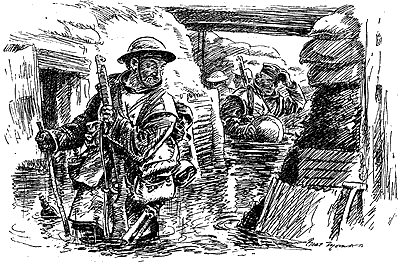
Jock (in captured trench “Coom Awa’ up here Donal’ ; it’s drier.”
DATE: April
11th, 1917
ARTIST: Bert Thomas
COMMENT: This and the following cartoon show more realistic drawings of trenches. 1917 was notable for the terrible weather conditions (possibly an atmospheric condition caused by the constant bombardments). Trench life became even more unpleasant as soldiers struggled with both mud and the worst winter in history.

DATE: October
1917
ARTIST: J.H.Dowd
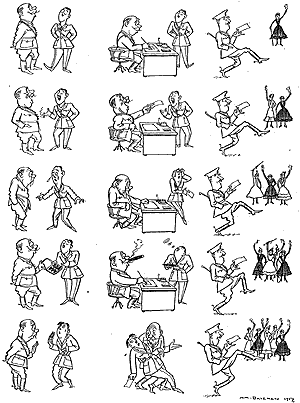
THE LEAVE-WANGLER
DATE: July
4th, 1917
ARTIST: H.R. Bateman.
COMMENT: A brilliantly subversive cartoon in which the officer uses the techniques of bribery, blagging and shellshock to attain leave. The increasing number of ladies cheering the soldier on suggests that wangling leave was now seen as a clever ruse rather than an act of cowardice. H.R. Bateman had been posted to the army, but was discharged sick in 1915, when he joined the Punch team as a junior cartoonist. His sequential art contains some of the most deviant depictions of the war, and become increasingly more prodigious from now on.
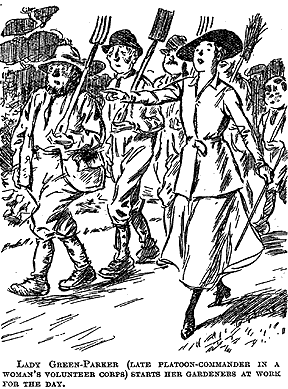
AFTER THE WAR: THE WAR-WORK HABIT.
DATE: The
Punch Almanack, 1917
ARTIST: (?)
COMMENT: Fears that women would continue to work after the war were particularly strong. Soldiers feared that not only would women have stolen their jobs from them when they returned, but that they would find Britain irrevocably changed from the land they had fought for as a result. Punch capitalized on this and the role of women was a very common theme. This cartoon comes from a series of four, all exaggerating and masculinising women’s behaviour as part of the workforce.
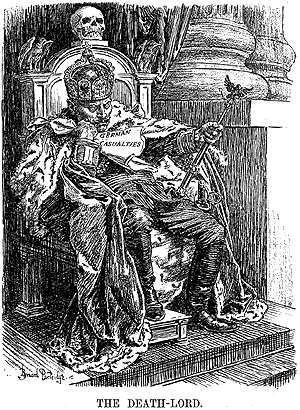
The Kaiser (on reading the appalling tale of German losses). What matter, so we Hohenzollens survive?
DATE: April 3rd, 1918
ARTIST: Bernard Patridge.
COMMENT: On 21st March, the German launched their greatest offensive against the Western Front. On 31st March, Lloyd George acknowledged that “The last man may count”. A ten mile gap appeared between the English and French lines as the Germans finally broke the trench line and advanced to within fifty miles of Paris. Hohenzollens are the German Royal family, of whom Kaiser Wilhelm II was the last.

DATE: 1918
ARTIST: Cyril Bird (as Fougasse)
COMMENT: An unusually realistic picture for Fougasse, who later drew art ion the style of H.R.Bateman and Ronald Searle. The art is simply composed but extremely effective.
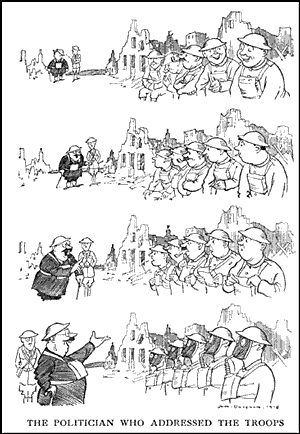
DATE: April 17th, 1918
ARTIST: H.M.Bateman
COMMENT: Two cartoons by Bateman, the first satirising the inability of politicians to understand the circumstances of war, and the second showing alternative uses for shells. Both are extremely subversive, suggesting the army is becoming more casual about the risks of fighting, and the second acknowledging the terrible quality of British shells. Unexploded shells are still being unearthed nearly 90 years later, and a very similar (diffused) shell casing is on display at Vimy Ridge.
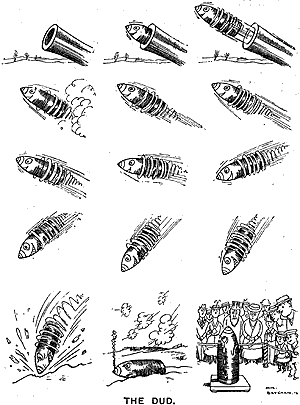
Read about Punch, Back to troop entertainments, Bairnsfather Cartoons, Modern Comics
